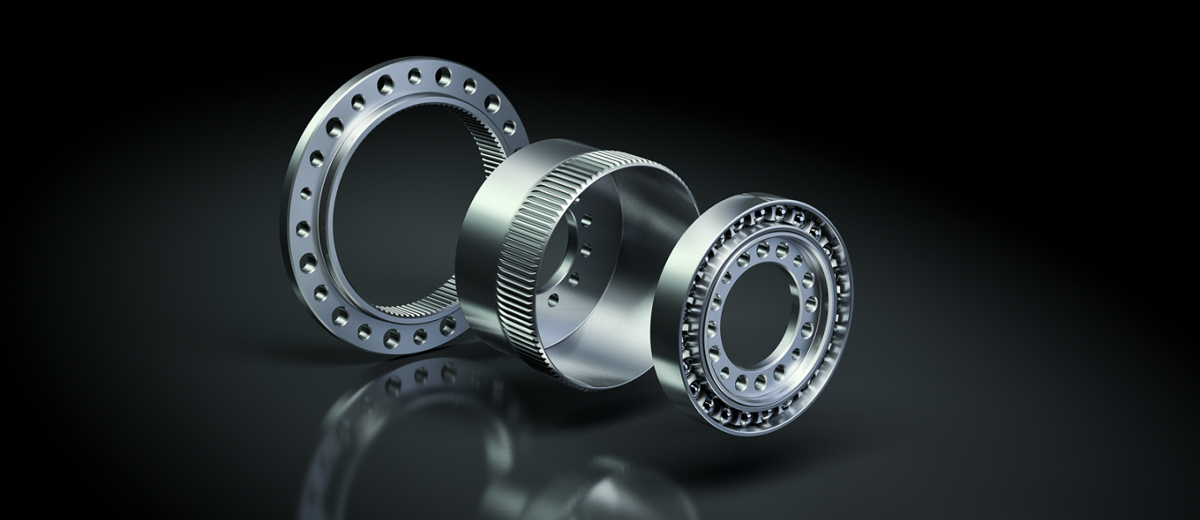
As a technical discipline, drive technology is concerned with overall ways of generating movement and supplying the energy and transmission systems that this requires. The main focus in this context is on the energy source, the propulsive source and the targeted operation of the system’s subcomponents. In some areas of application – in particular in the field of motor vehicle engineering – the powertrain also plays a central role; this component serves the purpose of transferring energy and represents the link between multiple system components.
No less diverse than the subject of drive technology are the numerous application fields in which gears, motors and associated components can be found. For example, special lightweight construction gears are used in the aerospace industry. It is essential that products employed in this environment are extremely robust and reliable products, and it is for this reason that Harmonic Drive® gears were used back in 1971 by NASA in the Apollo program. They can now be found orbiting the earth as components of several satellite systems. However, drive technology systems also perform much important work in small spaces. It is only thanks to them that machine tools and packaging machines are able to produce consumer goods economically and at constant quality. Precision gears play a forward-looking role in medical engineering, where they are integrated in therapeutic instruments to help patients regain vital functions, such as leg and hand mobility. Other fields of application in addition to those described above include semiconductor technology, machines used in the fields of measuring apparatus, glass and wood processing, and communications engineering.
However, one drive is not like another – the type of drive plays a decisive role in determining its optimum use. Relevant drive constructions include the electric type, based on electric motor technology, as well as pneumatic and hydraulic designs. The latter two come from the field of fluid technology and enable energy to be transmitted by means of either compressed air or hydraulic fluids, respectively.
The advantages generally associated with electrical drive technology include uncomplicated handling, precise control, and low maintenance costs. Characteristic of this type of drive is that they function by converting electrical energy to mechanical energy and the operation and functionality of the drive can be regulated to keep them working at a constant level despite variations in the dynamic conditions in which they are employed. Thanks to their progressive development, this type of drive technology is suitable for use in both small devices and large structures. It is highly likely that this area of electric drive technology will undergo an expansion of its applications thanks to the needs of renewable energies, which promise to be a sustainable new field for these devices.
Pneumatic drive technology also has a number of benefits. It generally has a relatively low purchase price, displays a high level of resistance to weathering and is simple to operate. These aspects explain the popularity of compressed-air-based drive technology in conjunction with transport systems and cleaning procedures. Once the compressed air is generated, it is usually released at predetermined positions by means of valves, where it generates movement. Unlike electrical drive technology, however, pneumatic equipment frequently displays an overall low efficiency level of less than 30 percent. In addition, the substantial change in volume that gases undergo under temperature or pressure changes are a serious disadvantage, as it makes precise movements with large forces impossible. A related field is hydraulic technology, which employs not gases but liquids. A particular advantage of this technology is that it is able to transmit enormous forces, as the liquids used undergo virtually no volume change.
It is centuries ago that talented inventors devised the first drive technology concepts and realised them in systems. In terms of their quality and efficiency, these constructions naturally cannot be compared with present-day standards of drive engineering, but they did bring about a considerable reduction in the stress of everyday life for the people that used them. It was in the year 240 B.C. that the Greek physicist and engineer Archimedes devised a multiple stage gearwheel winch that was able to convert released energy and reduce workloads.
Over time, both drive technology and its attendant disciplines and fields of application continued to develop. Solution-based systems became accessible for industrial purposes under the influence of technical and economic processes. For a large part of the twentieth century, cumulative power drives, in which a large number of machines were powered by a single central generator with the aid of transmission units, were still fairly common. Today, in contrast, the single drive has firmly established itself within the field of drive technology. In such systems, each of the various elements that are integrated into an assembly is powered by its own drive. This principle makes it possible to control each drive individually and to assign a variety of different operations.
A further milestone and trendsetting achievement of drive technology is the Harmonic Drive® strain wave gear, which was patented in 1955 by C. Walton Musser and has not lost any of its relevance to this day. Thanks to its outstanding properties in terms of torque capacity, weight, position, repetition precision and much more, it exceeds - sometimes very significantly - the performance levels of comparable systems. But it is not just in this context that Musser enriched the world of drive technology and mechanisms. With his guiding principle that it is never about whether a plan can be realised but whether one is prepared to invest the necessary time and effort, the American inventor had a significant effect on the spirit of invention throughout all of science.